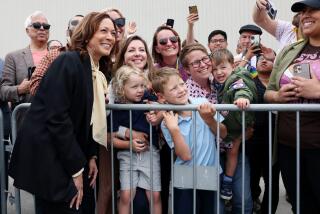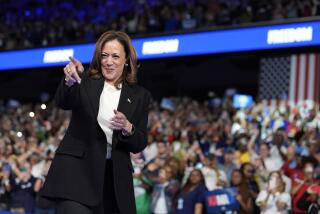THE TIMES POLL : Wilson Leads Brown Among Likely Voters : Her attempt to make the economy an issue fails to take hold. Clinton’s approval rating in the state hits a low.
Despite widespread concern about the economy and continuing disaffection with incumbent Gov. Pete Wilson, California voters would reelect Wilson over Democratic challenger Kathleen Brown if the November election were held today, the Los Angeles Times Poll has found.
Among voters likely to cast ballots, Wilson holds a 9-point lead, 50% to 41%. Among the larger group of registered voters, Wilson’s lead is a statistically insignificant 2 points, 46% to 44%. Still, it is a distinct reversal from the last Times poll taken in May, when Brown held a 10-point advantage over Wilson among registered voters, and other surveys dating back 18 months.
The survey found that Wilson has not markedly improved his standing among Californians, but rather that Brown has failed to sustain a groundswell of support for her own candidacy since her June nomination.
That was most apparent when voters were asked their views about the economy--commonly a bellwether for an incumbent’s chances of reelection. While 34% believe the state is in a serious recession and another 51% feel the state’s economy is mildly to moderately recessionary, Wilson is still regarded as the candidate best able to handle the economy.
The finding is sobering for Brown, who has sought to mine voter pessimism about the economy as she pushes toward the Nov. 8 election. The state treasurer has repeatedly characterized Wilson as not up to the job of managing the state’s fiscal troubles.
“They have made this their issue and they’re losing it,” said poll director John Brennan.
Wilson also got better grades from voters on two of the three other issues of major importance, crime and immigration, while Brown was credited with being better at only one, education.
In another blow to Democrats, President Clinton’s approval rating hit its lowest point since his election.
Still, Brennan cautioned that the high levels of voter discontent mean that no candidate or party can afford to be complacent. In a strong signal of dismay over the state of the state, fully 63% of voters said they believe California is headed in the wrong direction. Only 26% said it is on the right track.
“The landscape is still there for a Democratic victory,” Brennan said.
But the difficulties facing Democrats in general and their candidates in particular were brought into sharp relief by the Times poll, which was conducted Sept. 8-11. It showed that the strong tail wind that pushed Democrats to broad victories in 1992 has shifted drastically.
In October, 1992, for example, Democrats were seen by 46% of registered voters as the party best able to handle problems, while 32% sided with Republicans. Now, Republicans are narrowly seen as the best problem-solvers.
Clinton’s job rating in this all-important electoral state has also plummeted, hitting a low since his election of 44% positive, 49% negative. Since the last poll in May, the president’s approval rating has dropped 12 points and the percentage of voters who disapprove of him has risen 14 points. As recently as March, Clinton was given a positive rating by 59% of California voters.
The Times Poll surveyed 1,165 registered voters, including 721 considered likely to cast ballots in November. It was the first time the Times Poll isolated likely voters for this race. The margin of sampling error for registered voters is 3 points in either direction; for likely voters it is 4 points in either direction. Margins of error for smaller subgroups of voters may be larger.
Wilson’s slim 2-point lead over Brown among registered voters marked the first time in 18 months of polling that the governor has bested his Democratic challenger. In March, 1993, Brown held a walloping 22-point lead over Wilson, 53% to 31%. One year ago her lead was 8 points, and in polling that took place in March and May she was 10 points ahead.
Brown’s relative weaknesses were apparent when the poll broke down her support among influential voter groups.
The Democrat has lost ground in the last four months among whites, men, independents and the elderly, the poll found. Loyalty to her among Democratic men, a key constituency, was clearly lacking, with 31% of them supporting Wilson. In contrast, only 15% of Republican women, another highly watched group, had switched sides to support Brown.
“Her defections are greater than his among these battleground groups,” Brennan said.
Brown continues to lead among African Americans and Latinos, but a third of the latter group sides with Wilson. That is the same level of support he enjoyed from Latinos in 1990, indicating that his high-profile attacks on illegal immigration have thus far not cost him politically in this group.
Whatever bad news the poll delivered to Brown, it was clear that California voters are still not enamored of their incumbent chief executive.
Only 41% of adults and 44% of registered voters approve of the way Wilson is handling his gubernatorial duties, and about half of both groups disapprove. That was only a slight rise from May, when 38% of Californians and 39% of registered voters approved Wilson’s job handling.
Responding to another question, 47% of voters said they had a favorable impression of Wilson and the same percentage had an unfavorable impression. The numbers showed a slight improvement from May, when 43% viewed him favor ably and 52% negatively.
In contrast, Brown was viewed favorably by 46% and negatively by 33%. Her current numbers reflect a 2-point decline in favorability and a 6-point increase in unfavorable impressions since May.
Although a better comparison than Wilson’s, Brown’s numbers appeared somewhat soft. Among those who view both Brown and Wilson favorably, Wilson led by 55% to 29%. He also won among those who disliked both of them and among those who said they did not know enough about Brown to rate her.
Wilson’s lead over Brown on different issues of importance to California voters was striking. Asked who could best handle crime, half said Wilson and only 24% said Brown. Asked who could best handle problems stemming from illegal immigration, 49% said Wilson and 22% said Brown.
On the economy, an area widely thought by the Brown campaign to be Wilson’s vulnerable spot, 44% of the voters said the governor would do a better job and 32% said Democrat Brown would. The only category won by Brown was education, where she was favored by a wide 46%-24% margin.
Voters split on the candidates when it came to personal attributes. Asked who had the strongest leadership qualities, voters selected Wilson, 45% to 31%. Brown, however, was more popular as a candidate who “cares more about people,” 44% to 28%.
When the Times Poll probed the reasons voters supported or opposed a candidate, Wilson’s incumbency and Brown’s family ties--both elements that the respective campaigns have stressed--loomed large.
Among those who thought well of Wilson, 20% said it was because he was “doing the best he can.” Eleven percent cited his record as governor and 14% said they just liked him. His incumbency also cut against him, however. Among those who dislike Wilson, 15% said it was for his handling of the economy, 13% said he was ineffective, 10% disagreed with his education policies, and 10% said they simply didn’t like him.
The issues Wilson has pressed are paying off for him--15% of those who favored him said it was for his views on illegal immigration, while a much smaller 6% of his detractors said those views turned them against him. Similarly, 11% supported Wilson’s views on crime, while only 1% said those ideas hurt him.
Brown’s family ties helped propel her into the race, but the Times poll found that she is harmed as well as helped by her connections to two former governors, her father, Edmund G. (Pat) Brown Sr., and her brother, Edmund G. (Jerry) Brown Jr.
Fully one-quarter of those who have an unfavorable impression of Brown blamed it on dislike for her family, while on the positive side only 12% of those who liked her said it was because of her family.
Fifteen percent said they disliked her for no particular reason; the same percentage said they liked her for no particular reason. Critics said she was too wishy-washy (14%) or too liberal (11%). Supporters said they agreed with her views (12%) and liked that she is a Democrat (10%).
The death penalty was a marginal drag on Brown, with 6% of her detractors citing it as a reason they disliked her. But only 17% of all voters could accurately describe Brown’s position--that she personally opposes capital punishment but would enforce it as governor. Almost three in every 10 voters thought she was personally and politically opposed to the death penalty.
Unfortunately for Brown, an illumination of her position did not raise her standing with voters. Sixteen percent said they would be more inclined to vote for her because of her position, but 26% said they would be less likely to side with Brown.
How the Poll Was Conducted
The Times Poll interviewed 1,503 adults statewide, by telephone, Sept. 8-11. Included in the sample were 1,165 registered voters and 721 likely voters. Numbers were chosen from a list of all exchanges in the state. Random-digit dialing techniques were used so that listed and unlisted numbers could be contacted. Interviews were in English and Spanish. The sample was weighted slightly to conform more closely with census figures for sex, race, age and education. The margin of sampling error for the total and registered voter samples is plus or minus 3 percentage points; for likely voters it is 4 points. For certain subgroups, the error margin may be somewhat higher. Poll results can also be affected by factors such as the wording of questions and the order in which they are presented.
How Voters View the Race
GOP Gov. Pete Wilson leads Democrat Kathleen Brown in the race for governor among those likely to vote in November. When voters are asked which party can better handle the state’s problems, the GOP has a slight edge, reversing the trend of two years ago.
Which party do you think can do a better job of handling California’s problems?
***
If the election for governor were held today, who would you vote for?
Registered voters Likely voters Kathleen Brown 44% 41% Pete Wilson 46% 50% Someone else 1% 1% Don’t know 9% 8%
***
Why do you like Brown? (Among those who like her. Top responses volunteered.*) Nothing in particular/Just like her: 15% Like Brown family: 12% Has views that are like mine: 12% ***
Why do you dislike Brown? (Among those who dislike her. Top responses volunteered.*) Dislike Brown family: 25% Nothing in particular/Just dislike her: 15% She’s too wishy-washy: 14% ***
Why do you like Wilson? (Among those who like him. Top responses volunteered.*) Doing best he can/He’s trying: 20% His views on illegal immigration: 15% Nothing in particular/Just like him: 14% ***
Why do you dislike Wilson? (Among those who dislike him. Top responses volunteered.*) Hasn’t helped economy: 15% Ineffective: 13% Policies hurt education: 10% ***
Which candidate for governor . . .
Wilson Brown Can handle California’s crime problems 50% 24% Can handle illegal immigration problems 49% 22% Has stronger leadership qualities 45% 31% Can handle economy 44% 32% Cares more about people like me 28% 44% Can handle education system 24% 46%
* Numbers do not add up to 100% because not all answers are given.
Source: Los Angeles Times poll of California voters; Sept. 8-11.
More to Read
Get the L.A. Times Politics newsletter
Deeply reported insights into legislation, politics and policy from Sacramento, Washington and beyond. In your inbox three times per week.
You may occasionally receive promotional content from the Los Angeles Times.











